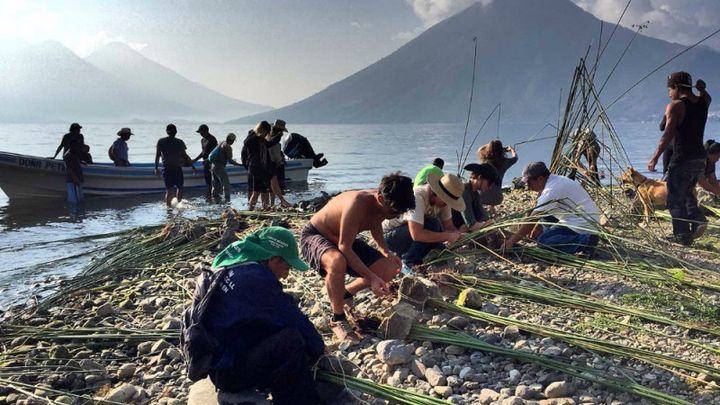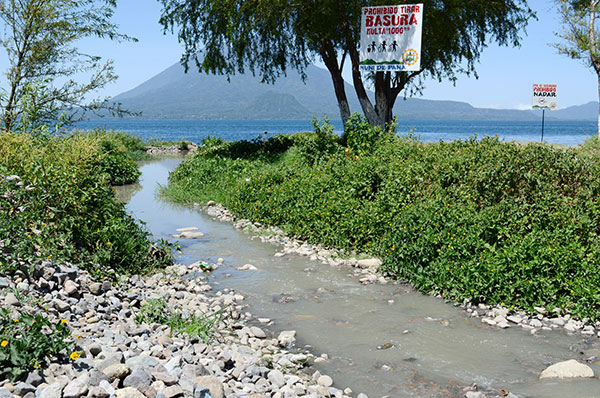
Tul Forests for Lake Atitlán
Lake Atitlan, Guatemala — which Lonely Planet calls “the closest thing to Eden on Earth" — is in desperate need of remediation due to wastewater contamination and chemical agricultural runoff. We at Lake Atitlán Environmental Interests Group are asking for your support to help reforest the lake with the Tul plant, which is a natural filter of pathogens and absorbs excess nutrients to promote a healthy ecosystem.
LAKE ATITLÁN IS DYING!
Lake Atitlán sits in a volcanic crater and has no outflow, so everything that goes in, stays in. This includes wastewater from at least 20 towns and chemical fertilizer and pesticide runoff from chemical agriculture. The scientific agency in charge of monitoring Lake Atitlán (AMSCLAE) says that without immediate action the Lake will be unrecoverable within 7 years.
 Sewage flowing into Lake Atitlan.
Sewage flowing into Lake Atitlan.
Beyond destroying its natural beauty, the contamination threatens the livelihoods of those who live by the Lake's waters (due to less tourism), as well as negatively affecting the health of the 200,000 people who use the Lake for their drinking water (roughly 20% of the population suffers from e-coli, amoebas, giardia, and other intestinal pathogens) . Tul helps to create a protective barrier along the shores and filter out pathogens and nutrients before they reach the Lake.
LAEIG is organizing a Tul Reforesting again for February 3rd and 4th for Tzununa. As of today (1/19/2017) the funding from this campaign has put over 2500 Tul plants in the water!!!!!!
Every $25 donation lets us add 10 Tul plants to the Tul Forests. That pays for the plants, 20 stones to anchor the plants, some rope, and expert help from local Mayan Tuleros, to make sure the plants thrive. Our goal is to raise $1,250 to support the planting of 500 Tul plants for our Dec. 3-4 planting and take a significant step forward in saving this natural treasure that is certainly close to your heart if you live here or at the top of your bucket list!

 Recurring Cyanobacteria blooms fed by excessive Nutrients now plague Lake Atitlán.
Recurring Cyanobacteria blooms fed by excessive Nutrients now plague Lake Atitlán.
WHY WE NEED YOUR HELP
Guatemala is infamous for corruption at all levels of government. Officially supplied funds simply cannot reach projects like these with any efficiency and the situation is urgent. We cannot wait for bureaucratic solutions. We must take action now to Save Lake Atitlán.
Local citizens are ready and standing by to help Save Lake Atitlán, but we depend on the international community to come up with the funds. The citizens of Atitlán know that by working together and enlisting the help of a global community of people who care about our Mother Earth, we can save Lake Atitlán.
OUR PHYTOREMEDIATION PROJECTS:
Phytoremediation is a natural, low-cost, solar-energy-driven cleanup technique that puts living plants in place to decrease contaminants in water and soils.
LAEIG members believe that phytoremediation is the quickest and least expensive way to help Lake Atitlán survive. Phytoremediation Projects help to mitigate the effects of the constantly increasing pollution, keeping the Lake alive while other systems are implemented that deal with the nutrient and pathogen problems at their sources.
We have identified three phytoremediation projects as the best and fastest ways possible to increase the filtering of pathogens and removal of nutrients from the Lake.
1. TUL REFORESTATION
Tul is a native plant that grows along the shores of Lake Atitlán. It grows rapidly and in the process absorbs nitrogen, phophorus, and other undesirable nutrients from the water. It becomes covered with a biofilm of bacteria that converts even more nutrients and filters the water that passes by.

Tul is one of the most important plants in the Lake for filtering pathogens (the biofilm growing on each plant)and absorbing excessive nutrients and preserving a healthy ecosystem. It serves as a home for fish, frogs, and other aquatic animal life as they grow and reproduce, maintaining healthy populations for the local communities that derive food sources from the Lake.
Tul is also used by the local Mayan craftsmen to make various products that they sell locally and export to foreign markets. Tul provides a critical source of income for many local families.
Several years ago, Lake Atitlán experienced an excessive loss of Tul forests due to a significant rise in water levels caused by an abnormally heavy rainy season. That was a double "punch to the gut" for Lake Atitlán. Not only did excessive amounts of nutrients wash into the Lake, triggering a cycle of recurring algae blooms, but also the Lake's natural defenses against contamination were severely damaged by the loss of Tul Forests and their natural filtrating actions.
Efforts have been underway ever since to reforest the Tul around the Lake and restore the natural filtration systems. Due to the impending crisis that Lake Atitlán is facing, it is vital that as much Tul as possible be restored to mitigate the effects of the constantly increasing pollution.
 Each plant has grown to around 20 in 6 months.
Each plant has grown to around 20 in 6 months.
 One Tul plant after a year and a half is several hundred!
One Tul plant after a year and a half is several hundred!
2. FLOATING GARDENS
LAEIG is gearing up to implement floating gardens in Lake Atitlán. Rafts covered with soil and plants will be anchored in the Lake to create floating garden "wetlands" that clean the water. The plant roots grow through the raft bottom into the lake, where they absorb nitrogen and phosphorous. Bacteria create a biofilm on the raft and roots that consumes nitrogen and phosphorous, converting them to less harmful substances.

Pollutants such as metals and particulates are also filtered out, since suspended solids bond to the biofilm. This makes the water clearer, which lets light penetrate deeper, thereby letting plants grow deeper, bringing oxygen deeper. Organic matter that attaches to the underside of the floating islands provides food for fish, and the islands provide habitat for birds. Planting floating gardens with commercially valuable plants can increase the impact of this project.
3. FLOATING RINGS
In this Phytoremediation project, floating rings will be placed in the lake, and the interior filled with water hyacinths. Water hyancinths are extremely fast growing, absorbing nutrients quickly and their roots hang down up to a foot below the surface creating a huge floating filtration area. Every couple of weeks, about half are harvested for use in composting operations to improve organic farming in the Lake Atitlán area thus removing nutrients from the lake and converting those nutrients into high quality organic compost for native farmers.
OUR TEAM

The Lake Atitlán Environmental Interests Group is an all-volunteer organization. We work in association with volunteers from many other organizations. LAEIG's nonprofit and NGO statuses are being processed, and meanwhile we are working full speed ahead.
Shawn Eisenhauer
Executive Director. An expert with over 20 years experience in the field of Lake Management, Shawn brings to the Team an extensive knowledge of Project Management, Bioremediation and Phytoremediation. He's responsible for the vision, strategy, development and coordination of new projects as we piece together the puzzle of remediating Lake Atitlán.
Ernesto Moscoso
Director of Watershed Management. Ernesto is currently working as the Director of Watersheds and Special Projects at MARN (Ministerio de Ambiente y Recursos Naturales).
Jairo Arreaga
Director of Risk Management. Jairo currently works with MARN as an Assessor for the National Coordination Director specializing in Risk Management.
Estuardo Bocel
Director of Wastewater Management. Estuardo is an Agroforestal Engineer at the Universidad del Valle de Guatemala Altiplano campus, in charge of both the water quality chemistry lab and the field work at Lake Atitlán.
Gaspar Yatáz-Pop
Director of Agricultural Applications. Gaspar is an Agroforestry Technician and Mathematician trained at the Universidad del Valle de Guatemala Altiplano campus.
Andres Tzina
Coffee Transition Coordinator
Andres is the President of APROCAMCA Organic Coffee Growers Cooperative and will be integral in helping chemical coffee farmers convert to Organic.
Maureen Abram
Director of Communications.
Gayla Groom
Assistant to the Executive Director. Gayla has decades of experience assisting nonprofits, as well as professional writing and editing skills and a range of administrative talents.
And many other individuals who Love Lake Atitlán!
Organizations we work with to help save the Lake include:
Rotary E-Club Lake Atitlán
Rotaract Guatemala de la Asunción
AMSCLAE
APROCAMCA Organic Coffee Growers Association.
¡Sembremos Tul!
WE NEED YOUR HELP
Working together, we can save this beautiful World Treasure and assure its responsible stewardship for future generations! Please like us on Facebook and share this campaign to help Save Lake Atitlán! And please make a donation to help fund our Tul plantings — the next one's coming up fast, on December 3 and 4!



